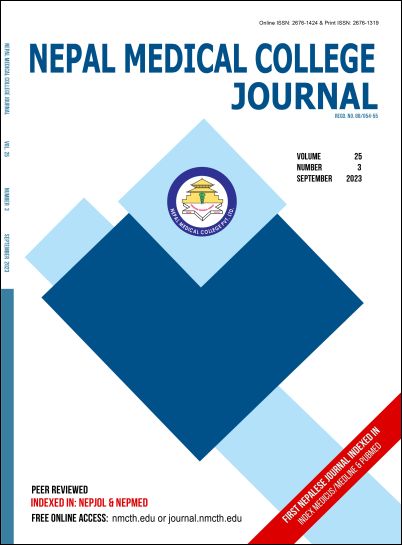High Resolution Computed Tomography chest findings among people affected by corona virus disease in a tertiary hospital of Nepal
DOI:
https://doi.org/10.3126/nmcj.v25i3.58712Keywords:
COVI9-19, corona virus, ground glass opacities, HRCT, CT -SSAbstract
Clinical assessment, chest X-ray (CXR) and chest high-resolution computed tomography (HRCT) are used in the management of Corona virus disease-19 (COVID-19). This retrospective cross sectional study included 251 patients admitted to Nepal Medical College Teaching Hospital (NMCTH) with a diagnosis of COVID‑19 infection confirmed by Reverse Transcriptase- Polymerase Chain Reaction (RT‑PCR). These patients underwent chest HRCT within the first two weeks of hospital admission. Images were evaluated for various HRCT findings & semi- quantitative CT Severity Score (CT –SS) was calculated based on the extent of lobar involvement. Out of 251 patients with positive RT PCR test, 127 were male (50.6%) and 124 female (49.4%). Typical bilateral peripheral subpleural ground glass opacities were demonstrated in 98.8% of patients; followed by thoracic lymphadenopathy (80.8%), interlobular septal thickening (80.4%),vascular changes (44.2%), focal consolidation (28.6%), consolidation with ground glass opacity (15%), pleural effusion (13.1%) bronchiectasis (3.8%), fibrotic changes (3.1%) and reversed halo pattern (0.7%). Calculated CT- SS showed moderate score in 130 patients (51.7%) followed by severe score in 67 patients (26.6%) and mild score in 51 patients (20.3%). HRCT can be used as a one stop radiological investigation for the diagnosis and prognosis of corona virus disease and CT -SS might be beneficial for diagnostic workflow in symptomatic cases.
Downloads
Downloads
Published
How to Cite
Issue
Section
License
Copyright (c) 2023 Nepal Medical College Journal

This work is licensed under a Creative Commons Attribution 4.0 International License.
This license enables reusers to distribute, remix, adapt, and build upon the material in any medium or format, so long as attribution is given to the creator. The license allows for commercial use.




